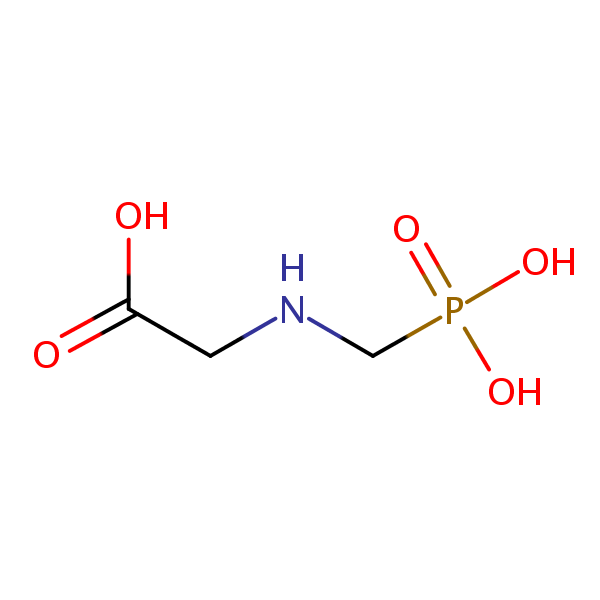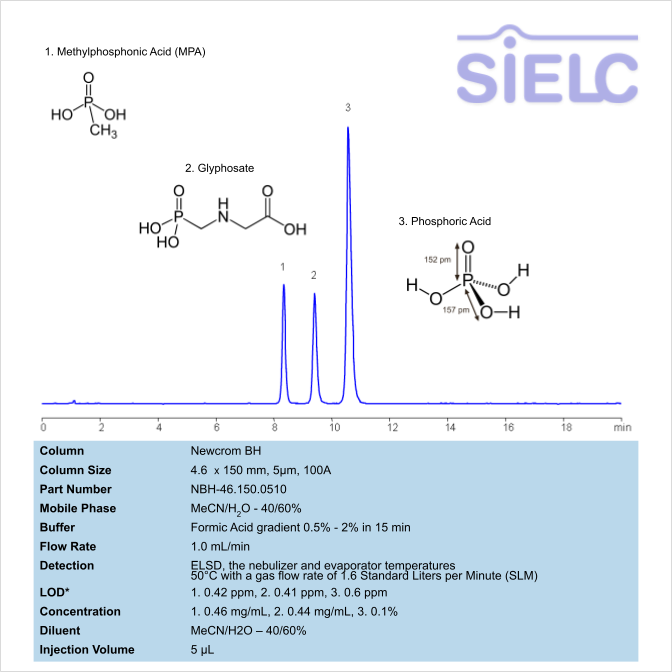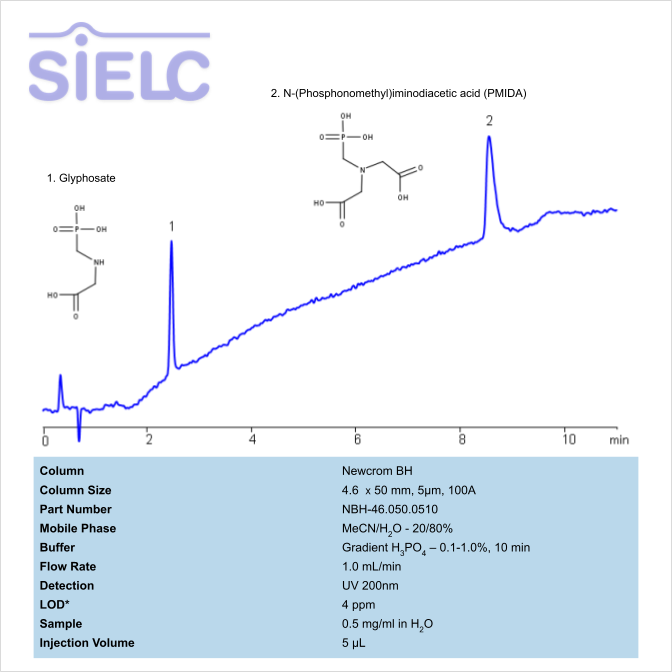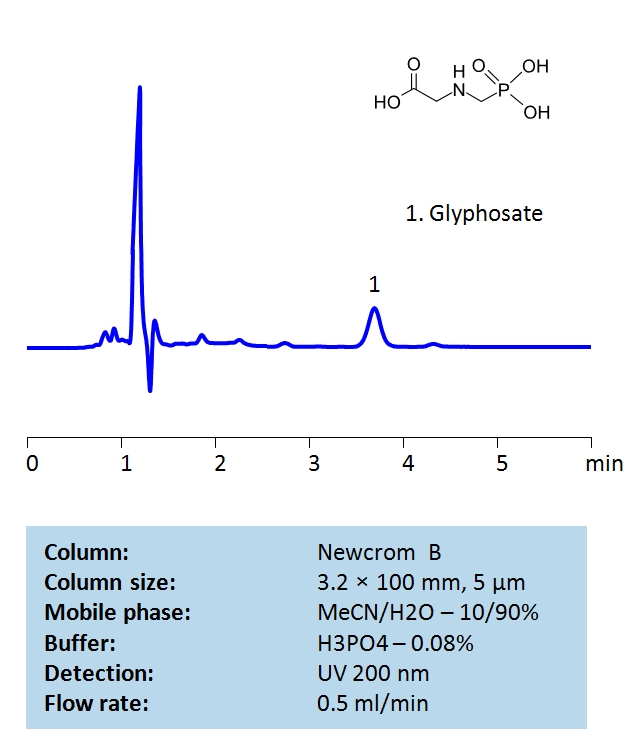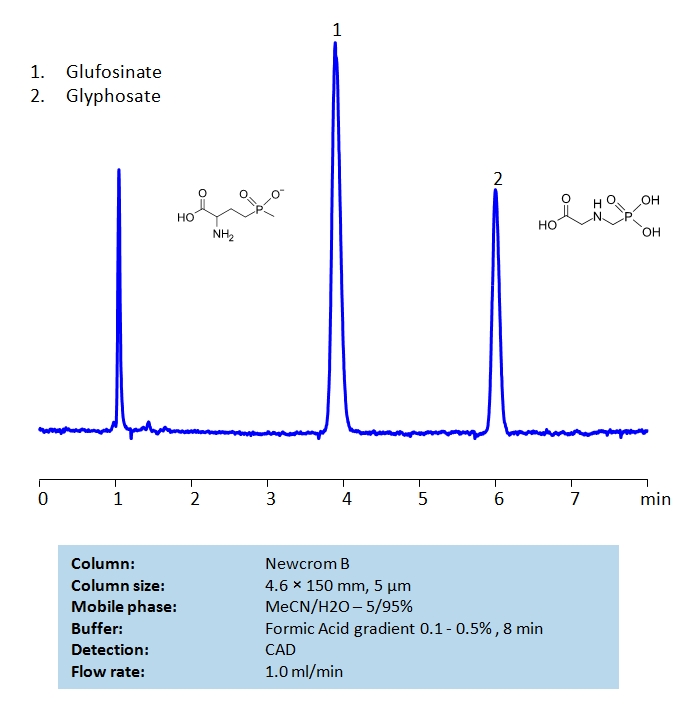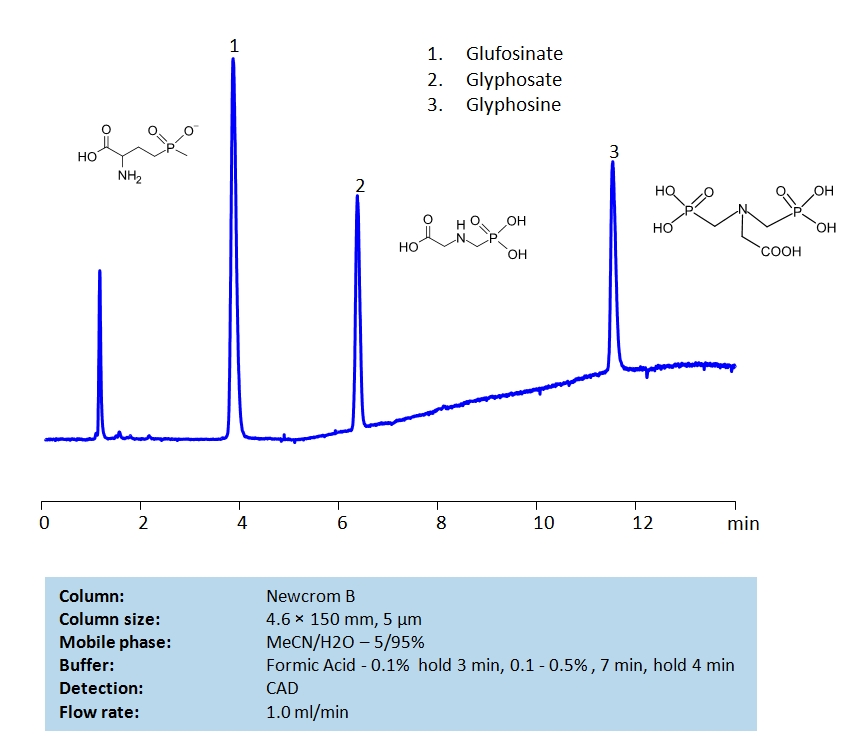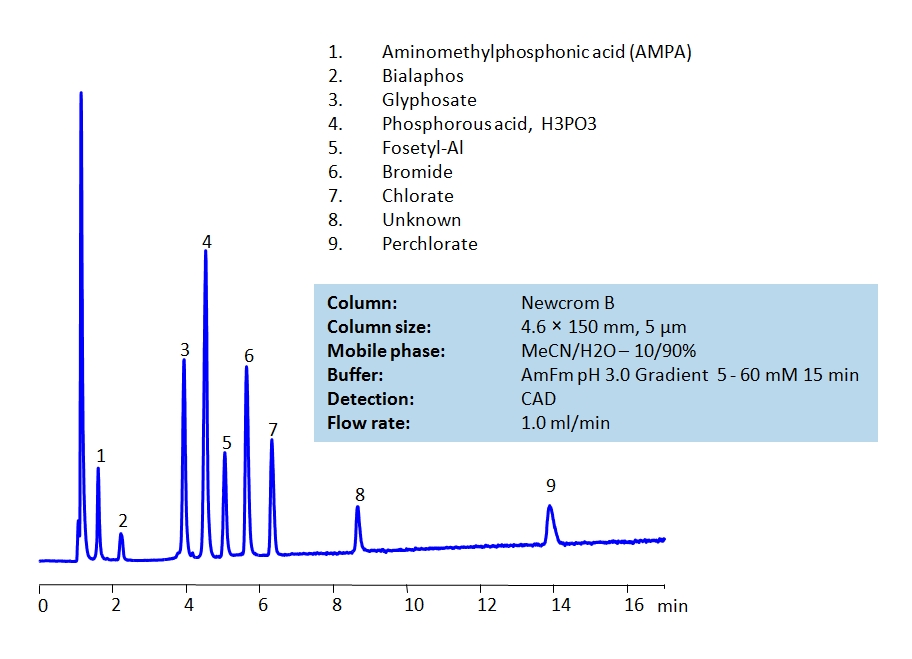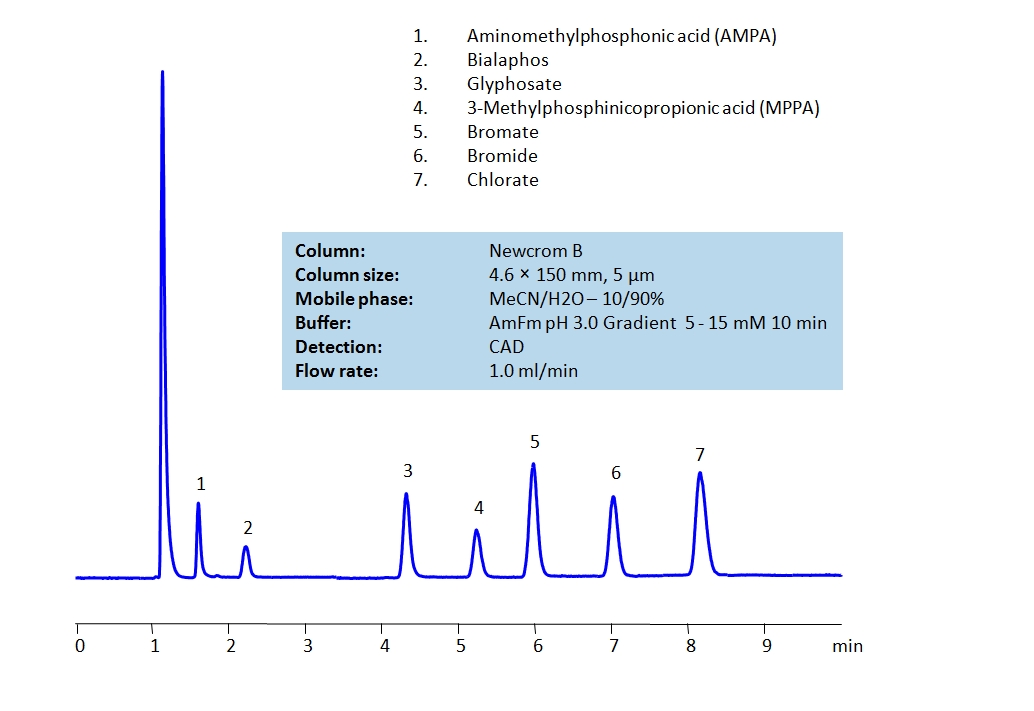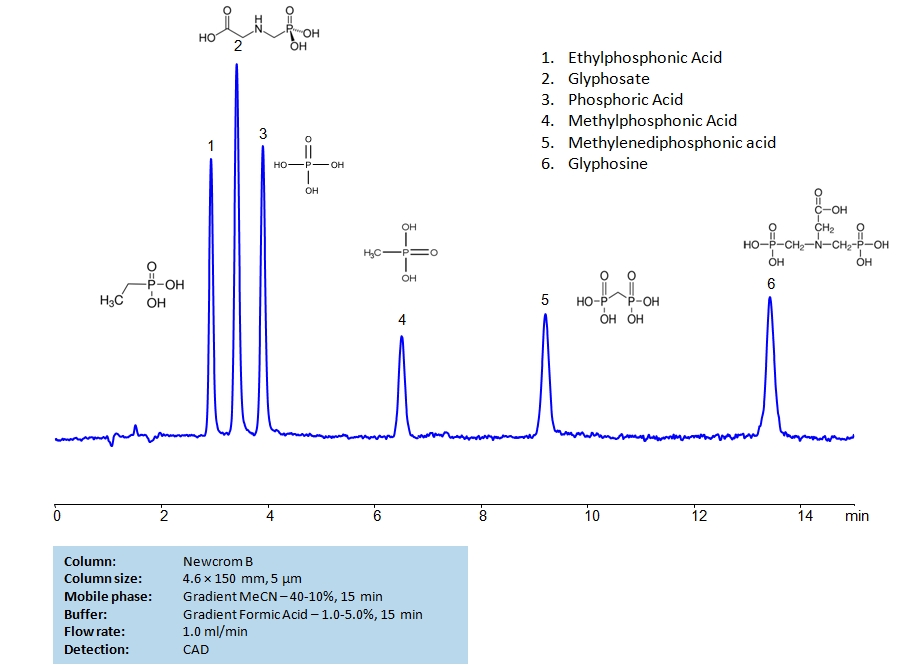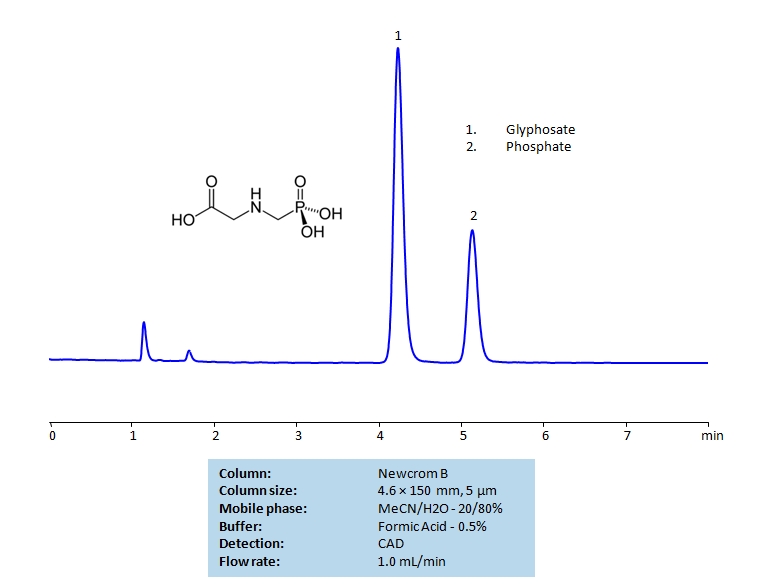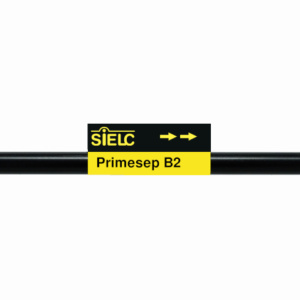| CAS Number | 1071-83-6 |
|---|---|
| Molecular Formula | C3H8NO5P |
| Molecular Weight | 169.073 |
| InChI Key | XDDAORKBJWWYJS-UHFFFAOYSA-N |
| LogP | -3.40 |
| Synonyms |
|
Applications:
HPLC–ELSD Method for the Analysis of Methylphosphonic Acid, Glyphosate, and Phosphoric Acid Using a Newcrom BH Column
December 15, 2025
HPLC Method for Methylphosphonic Acid, Glyphosate, Phosphoric Acid on Newcrom BH by SIELC Technologies
High Performance Liquid Chromatography (HPLC) Method for Analysis of Methylphosphonic Acid, Glyphosate, Phosphoric Acid.
Methylphosphonic acid is an organophosphorus compound with the chemical formula CH3P(OH)2. It is often used in some lubricant additives, textile treatments, and in synthesis of phosphonate compounds, like Glyphosate.
Glyphosate is an herbicide with a chemical formula of C3H8NO5P. It works through blocking enzymes, like 5-enolpyruvylshikimate-3-phosphate synthase, essential for plant growth. It is typically found in agricultural work, but can occasionally be found in forestry and garden care. You can find detailed UV spectra of Glyphosate and information about its various lambda maxima by visiting the following link.
Phosphoric acid is an inorganic compound with chemical formula H3PO4. It is odorless and colorless, which leads to it’s common use in soft drunks to help preserve the product. It is also used in fertilizers, metal treatment, and corrosion inhibition. Excessive intake of it is not recommended.
Methylphosphonic Acid, Glyphosate, Phosphoric Acid can be retained and analyzed using the Newcrom BH stationary phase column. The analysis utilizes a gradient method with a simple mobile phase consisting of water and acetonitrile (MeCN) with a phosphoric acid buffer. Detection is performed using UV.
| Column | Newcrom BH, 4.6 x 150 mm, 5 µm, 100 A, dual ended |
| Mobile Phase | MeCN/H2O – 40/60% |
| Buffer | Formic Acid gradient 0.5% – 2% in 15 min |
| Flow Rate | 1.0 mL/min |
| Detection | ELSD, the nebulizer and evaporator temperatures 50°C with a gas flow rate of 1.6 Standard Liters per Minute (SLM) |
| LOD* | 1. 0.42 ppm, 2. 0.41 ppm, 3. 0.6 ppm |
| Class of Compounds | Herbicides |
| Analyzing Compounds | Methylphosphonic Acid, Glyphosate, Phosphoric Acid |
Application Column
Newcrom BH
Column Diameter: 4.6 mm
Column Length: 150 mm
Particle Size: 5 µm
Pore Size: 100 A
Column options: dual ended
Methylphosphonic Acid
Phosphoric Acid

HPLC UV Method for Simultaneous Analysis of Glyphosate and N-(Phosphonomethyl)iminodiacetic acid (PMIDA) on Newcrom BH Column
December 11, 2025
HPLC Method for PMIDA (Phosphonomethyliminodiacetic acid), Glyphosate on Newcrom BH by SIELC Technologies
High Performance Liquid Chromatography (HPLC) Method for Analysis of PMIDA (Phosphonomethyliminodiacetic acid), Glyphosate.
Glyphosate is a broad-spectrum herbicide. It works through inhibiting the plant enzyme 5-enolpyruvylshikimate-3-phosphate synthase. The enzyme is essential for producing amino acids within the plant. Glyphosate is used across agriculture and forestry, as well as rare aquatic environments. It’s chemical formula is C3H8NO5P. You can find detailed UV spectra of Glyphosate and information about its various lambda maxima by visiting the following link.
N-(Phosphonomethyl)iminodiacetic acid, also known as PMIDA, is a key intermediate in the making of glyphosate. It has the chemical formula (HO)2P(O)CH2N(CH2CO2H)2. You can find detailed UV spectra of PMIDA and information about its various lambda maxima by visiting the following link.
PMIDA (Phosphonomethyliminodiacetic acid), Glyphosate can be retained and analyzed using the Newcrom BH stationary phase column. The analysis utilizes an isocratic method with a simple mobile phase consisting of water and acetonitrile (MeCN) with a phosphoric acid buffer. Detection is performed using UV.
| Column | Newcrom BH, 4.6 x 50 mm, 5 µm, 100 A, dual ended |
| Mobile Phase | MeCN/H2O |
| Buffer | Gradient H3PO4 – 0.1-1%, 10 min |
| Flow Rate | 1.0 ml/min |
| Detection | UV, 200 nm |
| LOD* | 4 ppm |
| Class of Compounds | Herbidices |
| Analyzing Compounds | PMIDA (Phosphonomethyliminodiacetic acid), Glyphosate |
Application Column
Newcrom BH
Column Diameter: 4.6 mm
Column Length: 50 mm
Particle Size: 5 µm
Pore Size: 100 A
Column options: dual ended
PMIDA (Phosphonomethyliminodiacetic acid)

UV-Vis Spectrum of Glyphosate
December 2, 2025
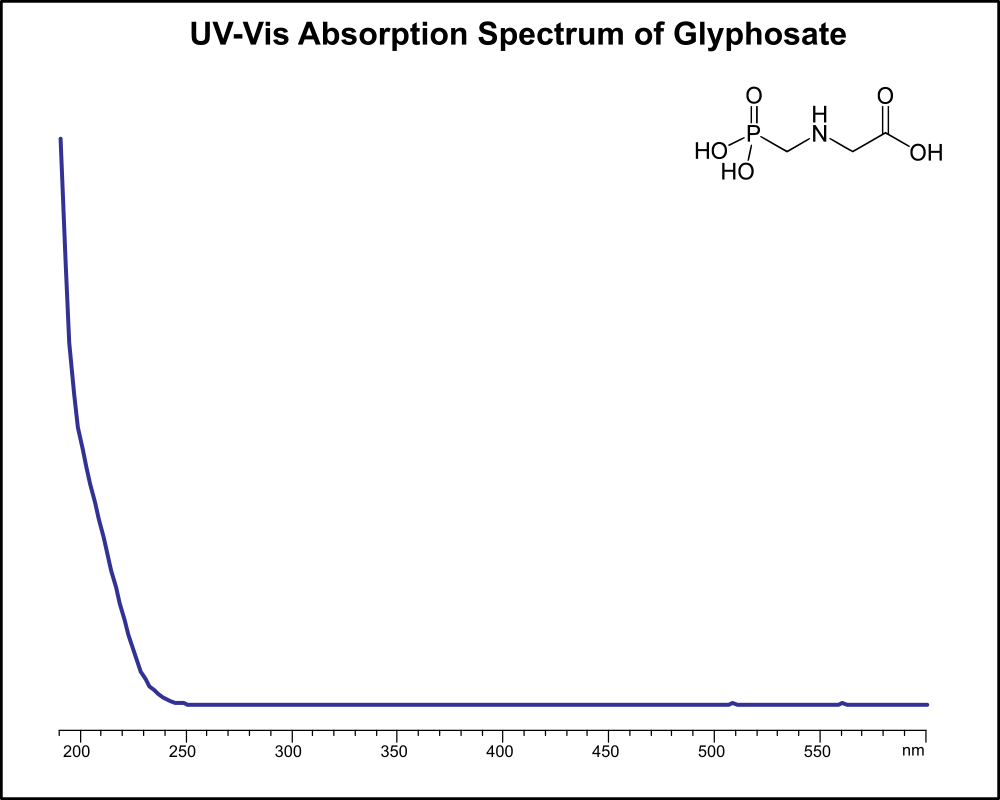
If you are looking for optimized HPLC method to analyze Glyphosate check our HPLC Applications library
For optimal results in HPLC analysis, it is recommended to measure absorbance at a wavelength that matches the absorption maximum of the compound(s) being analyzed. The UV spectrum shown can assist in selecting an appropriate wavelength for your analysis. Please note that certain mobile phases and buffers may block wavelengths below 230 nm, rendering absorbance measurement at these wavelengths ineffective. If detection below 230 nm is required, it is recommended to use acetonitrile and water as low UV-transparent mobile phases, with phosphoric acid and its salts, sulfuric acid, and TFA as buffers.
For some compounds, the UV-Vis Spectrum is affected by the pH of the mobile phase. The spectra presented here are measured with an acidic mobile phase that has a pH of 3 or lower.

HPLC Determination of Glyphosate on Newcrom B Column
March 5, 2021
HPLC Method for Glyphosate on Newcrom B by SIELC Technologies
High Performance Liquid Chromatography (HPLC) Method for Analysis of Glyphosate.
Glyphosate is a broad-spectrum herbicide. It works through inhibiting the plant enzyme 5-enolpyruvylshikimate-3-phosphate synthase. The enzyme is essential for producing amino acids within the plant. Glyphosate is used across agriculture and forestry, as well as rare aquatic environments. It’s chemical formula is C3H8NO5P.
Glyphosate can be retained in HPLC with a Newcrom B mixed-mode column using a mobile phase of acetonitrile (ACN, MeCN), water and phosphoric acid (H3PO4) buffer allowing the use of a UV detector at 200 nm.
| Column | Newcrom B, 3.2 x 100 mm, 5 µm, 100 A, dual ended |
| Mobile Phase | MeCN/H2O – 10/90% |
| Buffer | H3PO45 – 0.08% |
| Flow Rate | 0.5 mL/min |
| Detection | UV 200 nm |
| Class of Compounds | Hydrophobic, Herbicide, Pesticide |
| Analyzing Compounds | Glyphosate |
Application Column
Newcrom B
Column Diameter: 3.2 mm
Column Length: 100 mm
Particle Size: 5 µm
Pore Size: 100 A
Column options: dual ended

HPLC Separation of Glufosinate, Glyphosate and Glyphosine on Newcrom B Column
December 10, 2020
HPLC Method for Glufosinate, Glyphosate, Glyphosine on Newcrom B by SIELC Technologies
High Performance Liquid Chromatography (HPLC) Method for Analysis of Glufosinate, Glyphosate, Glyphosine.
Glufosinate is a naturally occurring herbicide. It is produced by Streptomyces soil bacteria and is used for weed control against broadleaf and grass weeds. It’s chemical formula is C5H12NO4P. The herbicide works through inhibiting glutamine synthetase, which is a key enzyme in plant metabolism. It is a sky and eye irritant, therefore it is encouraged to wear protective gear when handling Glufosinate.
Glyphosate is a broad-spectrum herbicide. It works through inhibiting the plant enzyme 5-enolpyruvylshikimate-3-phosphate synthase. The enzyme is essential for producing amino acids within the plant. Glyphosate is used across agriculture and forestry, as well as rare aquatic environments. It’s chemical formula is C3H8NO5P.
Glyphosine is a synthetic plant growth regulator. It is primarily used to hasten maturity of sugarcane., but at high levels it can also be used as herbicide due to it’s ability to cause chlorosis in emerging leaves. It’s chemical formula is C4H11NO8P2.
Glufosinate, Glyphosate, Glyphosine can be retained and analyzed using the Newcrom B stationary phase column. The analysis utilizes an isocratic method with a simple mobile phase consisting of water and acetonitrile (MeCN) with a formic acid buffer. Detection is performed using UV.
| Column | Newcrom B, 4.6 x 150 mm, 5 µm, 100 A, dual ended |
| Mobile Phase | MeCN/H2O – 5/95% |
| Buffer | Formic Acid Gradient |
| Flow Rate | 1.0 ml/min |
| Detection | CAD |
| Class of Compounds | Hydrophobic, Herbicide, Pesticide |
| Analyzing Compounds | Glufosinate, Glyphosate, Glyphosine |
Application Column
Newcrom B
Column Diameter: 4.6 mm
Column Length: 150 mm
Particle Size: 5 µm
Pore Size: 100 A
Column options: dual ended
Glyphosate
Glyphosine

HPLC Separation of Polar Pesticides on Newcrom B Column
November 19, 2020
HPLC Method for Glyphosate, Phosphorous acid, Fosetyl-Al, Bromide, Chlorate, Perchlorate, Bialaphos, Aminomethylphosphonic acid (AMPA), Bromate, Sodium Bromate, 3-(Methylphosphinico)propionic acid on Newcrom B by SIELC Technologies
High Performance Liquid Chromatography (HPLC) Method for Analysis of Glyphosate, Phosphorous acid, Fosetyl-Al, Bromide, Chlorate, Perchlorate, Bialaphos, Aminomethylphosphonic acid (AMPA), Bromate, Sodium Bromate, 3-(Methylphosphinico)propionic acid.
Pesticide is a more generic term that includes herbicides, fungicides and insecticides in its definition. Herbicides are used to control unwanted plants, they are also known as weedkillers. Insecticides are used to kill insects. Fungicides are used to kill parasitic fungi. All are heavily used in agriculture. By using HPLC, many different pesticides can be separated and their retention characteristics controlled using the Newcrom B mixed-mode column.
| Column | Newcrom B, 4.6 x 150 mm, 5 µm, 100 A, dual ended |
| Mobile Phase | MeCN/H2O – 10/90% |
| Buffer | AmFm pH 3.0 Gradient 5 – 60 mM 15 min |
| Flow Rate | 1 ml/min |
| Detection | CAD |
| Column | Newcrom B, 4.6 x 150 mm, 5 µm, 100 A, dual ended |
| Mobile Phase | MeCN/H2O – 10/90% |
| Buffer | AmFm pH 3.0 Gradient 5 – 15 mM 10 min |
| Flow Rate | 1 ml/min |
| Detection | CAD |
| Class of Compounds | Pesticides, Herbicides, Fungicides, Insecticides |
| Analyzing Compounds | Glyphosate, Phosphorous acid, Fosetyl-Al, Bromide, Chlorate, Perchlorate, Bialaphos, Aminomethylphosphonic acid (AMPA), Bromate, Sodium Bromate, 3-(Methylphosphinico)propionic acid |
Application Column
Newcrom B
Column Diameter: 4.6 mm
Column Length: 150 mm
Particle Size: 5 µm
Pore Size: 100 A
Column options: dual ended
Aminomethylphosphonic acid (AMPA)
Bialaphos
Bromate
Bromide
Chlorate
Fosetyl-Al
Glyphosate
Perchlorate
Phosphorous acid
Sodium Bromate

HPLC Separation of Glyphosate, Glyphosine, Ethylphosphonic, Methylphosphonic, Methylenediphosphonic and Phosphoric Acids on Newcrom B Column
December 4, 2019
HPLC Method for Ethylphosphonic Acid, Methylphosphonic Acid, Glyphosate, Glyphosine, Methylenediphosphonic acid, Phosphate, Phosphoric Acid on Newcrom B by SIELC Technologies
High Performance Liquid Chromatography (HPLC) Method for Analysis of Ethylphosphonic Acid, Methylphosphonic Acid, Glyphosate, Glyphosine, Methylenediphosphonic acid, Phosphate, Phosphoric Acid.
Glyphosate is an herbicide with a chemical formula of C3H8NO5P. It works through blocking enzymes, like 5-enolpyruvylshikimate-3-phosphate synthase, essential for plant growth. It is typically found in agricultural work, but can occasionally be found in forestry and garden care.
Glyphosine is a synthetic plant growth regulator with the chemical formula of C4H11NO8P2. It is a colorless liquid that works through decreasing chlorophyll production.
Ethylphosphonic acid has a C2H5P(O)(OH)2 chemical formula. It is typically found as white crystals or crystalline powder. It is often used as an internal standard when researching fosfomycin in human plasma as well as a synthetic nucleotide analog.
Methylphosphonic acid is an organophosphorus compound with the chemical formula CH3P(OH)2. It is often used in some lubricant additives, textile treatments, and in synthesis of phosphonate compounds, like the previously mentioned Glyphosate.
Methylenediphosphonic acid has the chemical formula CH2[P(O)(OH)2]2. It is typically seen as a precursor in synthesis of Mesoporous aluminum organophosphate, if alkyltrimethylammonium, and Tetraester of methylenediphosphonic acids.
Phosphoric acid is an inorganic compound with chemical formula H3PO4. It is odorless and colorless, which leads to it’s common use in soft drunks to help preserve the product. It is also used in fertilizers, metal treatment, and corrosion inhibition. Excessive intake of it is not recommended.
Ethylphosphonic Acid, Methylphosphonic Acid, Glyphosate, Glyphosine, Methylenediphosphonic acid, Phosphate, Phosphoric Acid can be retained and analyzed using the Newcrom B stationary phase column. The analysis utilizes an isocratic method with a simple mobile phase consisting of water and acetonitrile (MeCN) with a formic acid buffer. Detection is performed using CAD.
| Column | Newcrom B, 4.6 x 150 mm, 5 µm, 100 A, dual ended |
| Mobile Phase | MeCN Gradient -40-10%, 15 min |
| Buffer | Formic Acid Gradient -1- 5%, 15 min |
| Flow Rate | 1.0 ml/min |
| Detection | CAD |
| Class of Compounds | Acids, Plant growth regulator, Herbicide, Hydrophilic, Ionizable |
| Analyzing Compounds | Ethylphosphonic Acid, Methylphosphonic Acid, Glyphosate, Glyphosine, Methylenediphosphonic acid, Phosphate, Phosphoric Acid |
Application Column
Newcrom B
Column Diameter: 4.6 mm
Column Length: 150 mm
Particle Size: 5 µm
Pore Size: 100 A
Column options: dual ended
Glyphosate
Glyphosine
Methylenediphosphonic acid
Methylphosphonic Acid
Phosphate
Phosphoric Acid

HPLC Separation of Glyphosate, Ethylphosphonic Acid and Methylphosphonic Acid on Newcrom B Column
December 2, 2019
HPLC Method for Methylphosphonic Acid, Ethylphosphonic Acid, Glyphosate, Phosphate on Newcrom B by SIELC Technologies
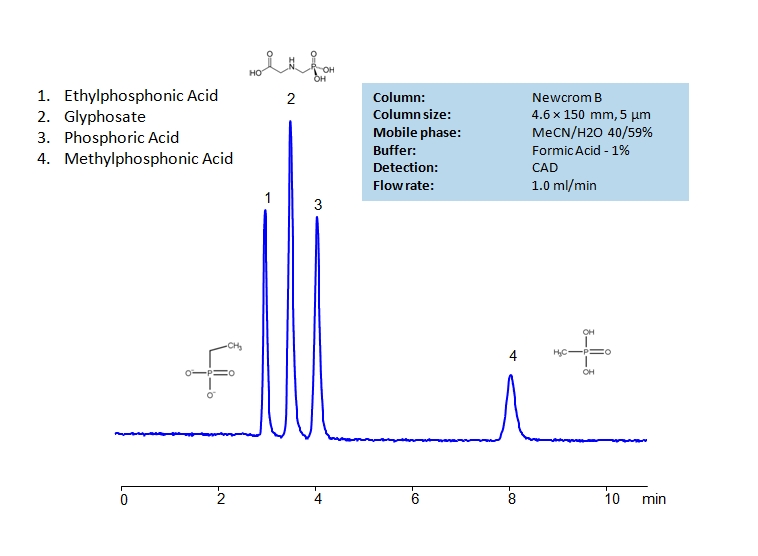 High Performance Liquid Chromatography (HPLC) Method for Analysis of Methylphosphonic Acid, Ethylphosphonic Acid, Glyphosate, Phosphate.
High Performance Liquid Chromatography (HPLC) Method for Analysis of Methylphosphonic Acid, Ethylphosphonic Acid, Glyphosate, Phosphate.
Ethylphosphonic acid has a C2H5P(O)(OH)2 chemical formula. It is typically found as white crystals or crystalline powder. It is often used as an internal standard when researching fosfomycin in human plasma as well as a synthetic nucleotide analog. Glyphosate is an herbicide with a chemical formula of C3H8NO5P. It works through blocking enzymes, like 5-enolpyruvylshikimate-3-phosphate synthase, essential for plant growth. It is typically found in agricultural work, but can occasionally be found in forestry and garden care.
Methylenediphosphonic acid has the chemical formula CH2[P(O)(OH)2]2. It is typically seen as a precursor in synthesis of Mesoporous aluminum organophosphate, if alkyltrimethylammonium, and Tetraester of methylenediphosphonic acids.
Phosphoric acid is an inorganic compound with chemical formula H3PO4. It is odorless and colorless, which leads to it’s common use in soft drunks to help preserve the product. It is also used in fertilizers, metal treatment, and corrosion inhibition. Excessive intake of it is not recommended.
Methylphosphonic Acid, Ethylphosphonic Acid, Glyphosate, Phosphate can be retained and analyzed using the Newcrom B stationary phase column. The analysis utilizes an isocratic method with a simple mobile phase consisting of water and acetonitrile (MeCN) with a formic acid buffer. Detection is performed using CAD.
| Column | Newcrom BH, 4.6 x 150 mm, 5 µm, 100 A, dual ended |
| Mobile Phase | MeCN/H2O – 40/59% |
| Buffer | Formic Acid – 1% |
| Flow Rate | 1.0 ml/min |
| Detection | CAD |
| Class of Compounds | Ions, Hydrophilic, Ionizable |
| Analyzing Compounds | Methylphosphonic Acid, Ethylphosphonic Acid, Glyphosate, Phosphate |
Application Column
Newcrom BH
Column Diameter: 4.6 mm
Column Length: 150 mm
Particle Size: 5 µm
Pore Size: 100 A
Column options: dual ended
Glyphosate
Methylphosphonic Acid
Phosphate

HPLC Separation of Glyphosate and Phosphate Ion on Newcrom B Column
December 2, 2019
HPLC Method for Glyphosate, Phosphate on Newcrom B by SIELC Technologies
High Performance Liquid Chromatography (HPLC) Method for Analysis of Glyphosate and Phosphate Ion
Glyphosate is a broad-spectrum herbicide which is used to kill weeds. The presence of glyphosate is strongly regulated by various governing agencies in the US, Europe, and Asia. Glyphosate is characterized by its carboxylic acid and phosphate group on either end.
Glyphosate and phosphate ions can be retained and separated with a Newcrom B mixed-mode column using a mobile phase consisting of acetonitrile (MeCN), water, and formic acid (H3PO4) as a buffer. This method is compatible with mass spectrometry and be detected via a Charged aerosol detector (CAD).
| Column | Newcrom B, 4.6 x 150 mm, 5 µm, 100 A, dual ended |
| Mobile Phase | MeCN – 20% |
| Buffer | Formic Acid – 0.5% |
| Flow Rate | 1.0 ml/min |
| Detection | CAD |
| Class of Compounds |
Insecticide, Herbicide, Fungicide, Hydrophobic, Ionizable |
| Analyzing Compounds | Glyphosate, Phosphate |
Application Column
Newcrom B
Column Diameter: 4.6 mm
Column Length: 150 mm
Particle Size: 5 µm
Pore Size: 100 A
Column options: dual ended
Phosphate

Separation of Herbicides Paraquat, Diquat and Glyphosate in One Run with LC/MS Compatible Conditions
December 5, 2013
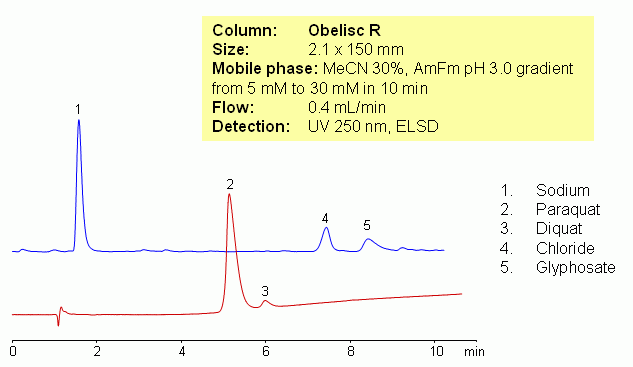
There is a need to separate different herbicides and pesticides in one run with LC/MS compatible conditions. Paraquat, diquat and glyphosate were separated on reversed-phase tri-modal cation- and anion-exchange column (Obelisc R) and on HILIC/ion-exchange columns (Obelisc N). Method explores unique properties of mixed-mode stationary phase which retains and separates cations like paraquat and diquat and anions/zwitter-ions like glyphosate in one run. Since columns are compatible with 100% organic and 100% water, a wide range of gradients can be used for analysis as well as isocratic conditions where it is desired. Method can be used for quantitation of these compounds in various matrices (soil, ground water, crops, food, etc.)
| Column | Obelisc R, 2.1×150 mm, 5 µm, 100A |
| Mobile Phase | MeCN – 30% |
| Buffer | Gradient AmFm pH 3.0 – 5-30 mM, 10 min |
| Flow Rate | 0.4 ml/min |
| Detection | UV, 250 nm, ELSD |
| Class of Compounds |
Insecticide, Herbicide, Fungicide, Hydrophobic, Ionizable |
| Analyzing Compounds | Paraquat, Diquat, Glyphosate |
Application Column
Obelisc N
SIELC has developed the Obelisc™ columns, which are mixed-mode and utilize Liquid Separation Cell technology (LiSC™). These cost-effective columns are the first of their kind to be commercially available and can replace multiple HPLC columns, including reversed-phase (RP), AQ-type reversed-phase, polar-embedded group RP columns, normal-phase, cation-exchange, anion-exchange, ion-exclusion, and HILIC (Hydrophilic Interaction Liquid Chromatography) columns. By controlling just three orthogonal method parameters - buffer concentration, buffer pH, and organic modifier concentration - users can adjust the column properties with pinpoint precision to separate complex mixtures.
Select optionsObelisc R
SIELC has developed the Obelisc™ columns, which are mixed-mode and utilize Liquid Separation Cell technology (LiSC™). These cost-effective columns are the first of their kind to be commercially available and can replace multiple HPLC columns, including reversed-phase (RP), AQ-type reversed-phase, polar-embedded group RP columns, normal-phase, cation-exchange, anion-exchange, ion-exclusion, and HILIC (Hydrophilic Interaction Liquid Chromatography) columns. By controlling just three orthogonal method parameters - buffer concentration, buffer pH, and organic modifier concentration - users can adjust the column properties with pinpoint precision to separate complex mixtures.
Select optionsGlyphosate
Paraquat
UV Detection

Separation of Paraquat, Diguat, and Glyphosate on Obelisc R Column
July 3, 2013
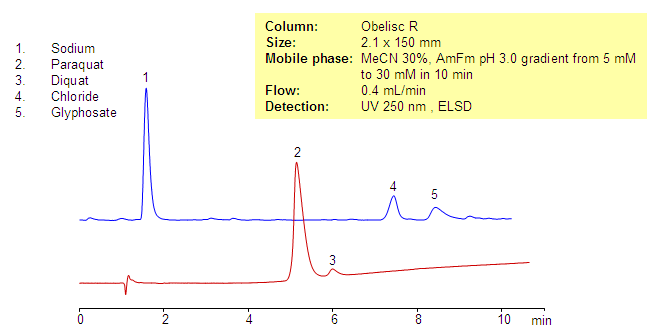
Paraquat, diquat and glyphosate are three of most widely used herbicides in the world. Paraquat and diquat are very polar and very basic quaternary amines. Glyphosate is an aminophosphonic analog of glycine. It is very polar and acidic at most of the pH of the mobile phase. Since glyphosate and the quats have opposite charges no ion-pairing method can be developed for the mixture of basic and acidic herbicides. All three herbicides were separated on the Obelisc R tri-modal column. Paraquat and diquat are retained by a cation-exchange mechanism, and glyphosate is retained by weak reversed-phase and strong anion-exchange mechanisms. This method can be used for analysis of common herbicides in fruits, vegetables, ground water, drinking water and other matrices. Method is LC/MS compatible and can be used to determine trace levels of herbicides.
| Column | Obelisc R, 2.1×150 mm, 5 µm, 100A |
| Mobile Phase | MeCN – 30% |
| Buffer | Gradient AmFm pH 3.0 – 5-30 mM, 10 min |
| Flow Rate | 0.4 ml/min |
| Detection | UV, 250 nm, ELSD |
| Class of Compounds |
Insecticide, Herbicide, Fungicide, Hydrophobic, Ionizable |
| Analyzing Compounds | Paraquat, Diquat, Glyphosate |
Application Column
Obelisc R
SIELC has developed the Obelisc™ columns, which are mixed-mode and utilize Liquid Separation Cell technology (LiSC™). These cost-effective columns are the first of their kind to be commercially available and can replace multiple HPLC columns, including reversed-phase (RP), AQ-type reversed-phase, polar-embedded group RP columns, normal-phase, cation-exchange, anion-exchange, ion-exclusion, and HILIC (Hydrophilic Interaction Liquid Chromatography) columns. By controlling just three orthogonal method parameters - buffer concentration, buffer pH, and organic modifier concentration - users can adjust the column properties with pinpoint precision to separate complex mixtures.
Select optionsDiquat
Glyphosate
Paraquat
Sodium
UV Detection

Method for Analysis of Glyphosate in Apple Juice, Cranberry Juice, Mango Juice and Green Tea
July 3, 2013
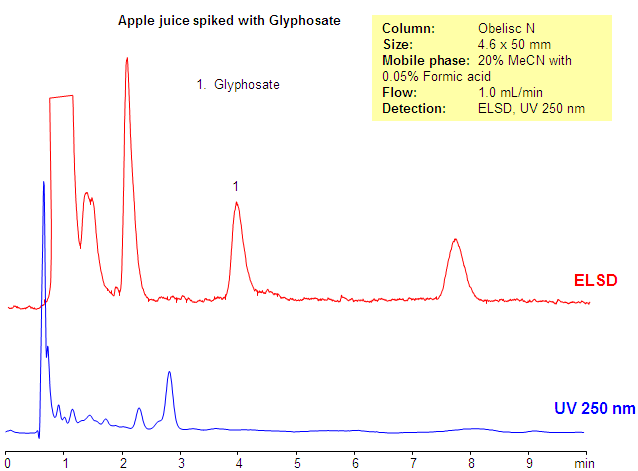
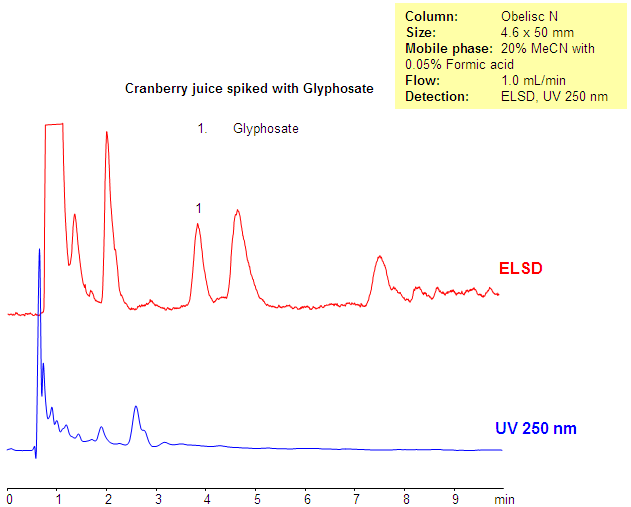
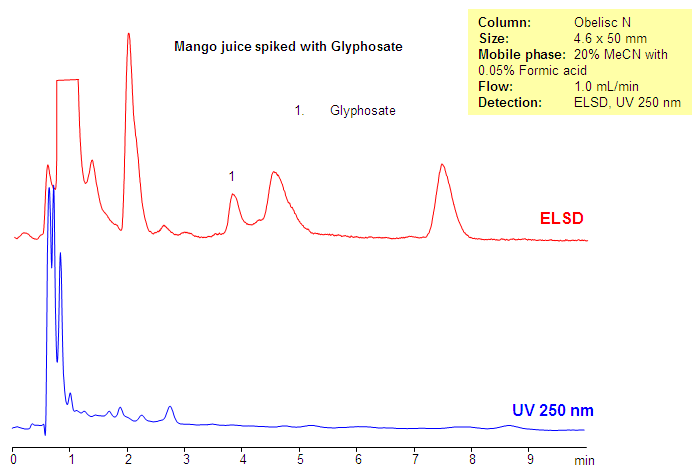
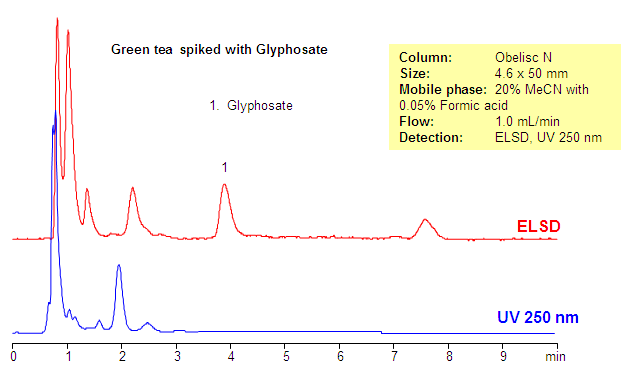
Glyphosate is a broad-spectrum herbicide which is used to kill weeds. Presence of glyphosate is strongly regulated by various governing agencies in the US, Europe, and Asia. Method for analysis of glyphosate in fruit juices and teas was developed using the Obelisc N HILIC/ion-exchange column. Glyphosate is retained by an ion-exchange mechanism. Since the method uses a highly aqueous mobile phase, which is not usual, for HILIC columns, none of the sugars, vitamins and other components of juices interfere with the analysis of glyphosate. Samples of juices were spiked with glyphosate. This method can be used in combination with LC/MS for determination of very low concentrations of glyphosate in various fruits and vegetables as well as ground and drinking water.
| Column | Obelisc N, 4.6×50 mm, 5 µm, 100A |
| Mobile Phase | MeCN/H2O – 20/80% |
| Buffer | Formic acid – 0.05% |
| Flow Rate | 1.0 ml/min |
| Detection | UV, 250 nm, ELSD |
| Class of Compounds |
Herbicide, Hydrophilic, Ionizable |
| Analyzing Compounds | Glyphosate |
Application Column
Obelisc N
SIELC has developed the Obelisc™ columns, which are mixed-mode and utilize Liquid Separation Cell technology (LiSC™). These cost-effective columns are the first of their kind to be commercially available and can replace multiple HPLC columns, including reversed-phase (RP), AQ-type reversed-phase, polar-embedded group RP columns, normal-phase, cation-exchange, anion-exchange, ion-exclusion, and HILIC (Hydrophilic Interaction Liquid Chromatography) columns. By controlling just three orthogonal method parameters - buffer concentration, buffer pH, and organic modifier concentration - users can adjust the column properties with pinpoint precision to separate complex mixtures.
Select optionsUV Detection

Method for Analysis of Glyphosate in Cranberry Juice
July 3, 2013

| Column | Obelisc N, 4.6×50 mm, 5 µm, 100A |
| Mobile Phase | MeCN/H2O – 20/80% |
| Buffer | Formic acid – 0.05% |
| Flow Rate | 1.0 ml/min |
| Detection | UV, 250 nm, ELSD |
| Class of Compounds |
Herbicide, Hydrophilic, Ionizable |
| Analyzing Compounds | Glyphosate |
Application Column
Obelisc N
SIELC has developed the Obelisc™ columns, which are mixed-mode and utilize Liquid Separation Cell technology (LiSC™). These cost-effective columns are the first of their kind to be commercially available and can replace multiple HPLC columns, including reversed-phase (RP), AQ-type reversed-phase, polar-embedded group RP columns, normal-phase, cation-exchange, anion-exchange, ion-exclusion, and HILIC (Hydrophilic Interaction Liquid Chromatography) columns. By controlling just three orthogonal method parameters - buffer concentration, buffer pH, and organic modifier concentration - users can adjust the column properties with pinpoint precision to separate complex mixtures.
Select optionsUV Detection

Method for Analysis of Glyphosate in Mango Juice
July 3, 2013

UV Detection

Method for Analysis of Glyphosate in Green Tea
July 3, 2013

| Column | Obelisc N, 4.6×50 mm, 5 µm, 100A |
| Mobile Phase | MeCN/H2O – 20/80% |
| Buffer | Formic acid – 0.05% |
| Flow Rate | 1.0 ml/min |
| Detection | UV, 250 nm, ELSD |
| Class of Compounds |
Herbicide, Hydrophilic, Ionizable |
| Analyzing Compounds | Glyphosate |
Application Column
Obelisc N
SIELC has developed the Obelisc™ columns, which are mixed-mode and utilize Liquid Separation Cell technology (LiSC™). These cost-effective columns are the first of their kind to be commercially available and can replace multiple HPLC columns, including reversed-phase (RP), AQ-type reversed-phase, polar-embedded group RP columns, normal-phase, cation-exchange, anion-exchange, ion-exclusion, and HILIC (Hydrophilic Interaction Liquid Chromatography) columns. By controlling just three orthogonal method parameters - buffer concentration, buffer pH, and organic modifier concentration - users can adjust the column properties with pinpoint precision to separate complex mixtures.
Select optionsUV Detection

Effect of pH on Separation of Glyphosate and Ethylphosphonic Acid
July 8, 2011
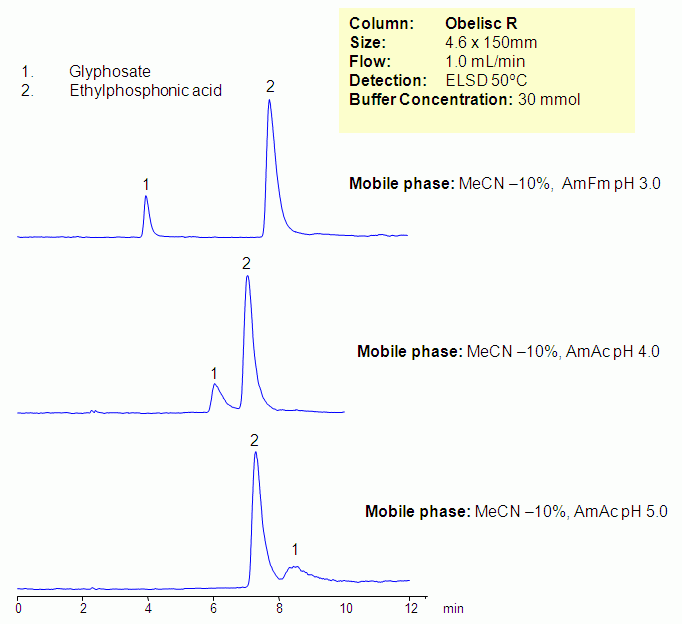
Glyphosate is broad spectrum herbicide to kill weeds. Presence of glyphosate in water, fruits and veggies is regulated. Alkylphosphonic acids are decomposition byproducts of chemical warfare agents. Analysis of phosphonic acid in water is regulated by Environmental Protection Agency (EPA). All phosphonic acids are polar acidic compounds. Method was developed for glyphosate and ethylphosphonic acid. Both compounds are retained by ion-exchange mechanism. Method is compatible with LC/MS and can be used for analysis of glyphosate and alkylphosphonic acids in various matrices.
| Column | Obelisc R, 4.6×150 mm, 5 µm, 100A |
| Mobile Phase | MeCN – 10% |
| Buffer | AmAc |
| Flow Rate | 1.0 ml/min |
| Detection | ELSD 50C |
<
| Class of Compounds |
Insecticide, Herbicide, Fungicide, Hydrophobic, Ionizable |
| Analyzing Compounds | Glyphosate, Ethylphosphonic acid |
Application Column
Obelisc R
SIELC has developed the Obelisc™ columns, which are mixed-mode and utilize Liquid Separation Cell technology (LiSC™). These cost-effective columns are the first of their kind to be commercially available and can replace multiple HPLC columns, including reversed-phase (RP), AQ-type reversed-phase, polar-embedded group RP columns, normal-phase, cation-exchange, anion-exchange, ion-exclusion, and HILIC (Hydrophilic Interaction Liquid Chromatography) columns. By controlling just three orthogonal method parameters - buffer concentration, buffer pH, and organic modifier concentration - users can adjust the column properties with pinpoint precision to separate complex mixtures.
Select optionsGlyphosate

HPLC Separation of Glyphosate Reaction Intermediates and Impurities
March 3, 2010

Glyphosate and intermediates/impurities of production are separated on an Obelisc N HILIC/ion-exchange column by a combination of HILIC and ion-exchange mechanism. Method can be used in analysis of glyphosate, iminodiacetic acid, (N-phosphonomethyl)-imminodiacetic acid, diethanolamine and related impurities in reaction mixtures, waste and ground waters. Detection techniques are LC/MS, ELSD, CAD and UV.
| Column | Obelisc N, 4.6×150 mm, 5 µm, 100A |
| Mobile Phase | MeCN/H2O |
| Buffer | Ammonium Formate |
| Flow Rate | 1.0 ml/min |
| Detection | ELSD |
| Class of Compounds |
Herbicide, Hydrophilic, Ionizable |
| Analyzing Compounds | Glyphosate, IDA, PMIDA, DEA |
Application Column
Obelisc N
SIELC has developed the Obelisc™ columns, which are mixed-mode and utilize Liquid Separation Cell technology (LiSC™). These cost-effective columns are the first of their kind to be commercially available and can replace multiple HPLC columns, including reversed-phase (RP), AQ-type reversed-phase, polar-embedded group RP columns, normal-phase, cation-exchange, anion-exchange, ion-exclusion, and HILIC (Hydrophilic Interaction Liquid Chromatography) columns. By controlling just three orthogonal method parameters - buffer concentration, buffer pH, and organic modifier concentration - users can adjust the column properties with pinpoint precision to separate complex mixtures.
Select optionsGlyphosate
IDA (Iminodiacetic acid)
PMIDA (Phosphonomethyliminodiacetic acid)

HPLC Separation of Glyphosate Production Intermediates
January 13, 2010
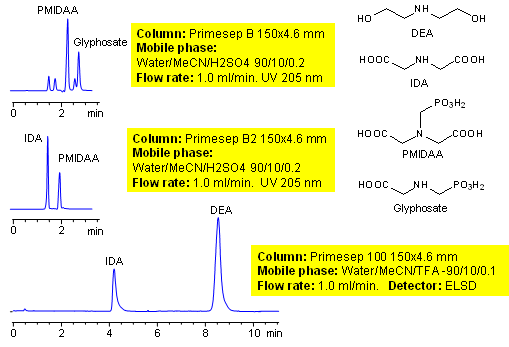
Glyphosate is a broad spectrum herbicide used to kill weeds. It is the most used herbicide. Glyphosate is an aminophosphonic analogue of the natural amino acid glycine. Glyphosate and its intermediates are very polar ionic compounds derived from glycine. Neither of intermediates can be retained on traditional reversed-phase columns. Two methods for glyphosate intermediates were developed on Primesep B, Primesep B2 and Primesep 100 columns.
| Column | Primesep B, Primesep B2, Primesep 100, 4.6×150 mm, 5 µm, 100A |
| Mobile Phase | MeCN/H2O |
| Buffer | TFA, H2SO4 |
| Flow Rate | 1.0 ml/min |
| Detection | ELSD |
| Class of Compounds |
Insecticide, Herbicide, Fungicide, Hydrophobic, Ionizable |
| Analyzing Compounds | Glyphosate, PMIDAA, IDA |
Application Column
Primesep 100
The Primesep family of mixed-mode columns offers a wide variety of stationary phases, boasting unprecedented selectivity in the separation of a broad array of chemical compounds across multiple applications. Corresponding Primesep guard columns, available with all stationary phases, do not require holders. SIELC provides a method development service available to all customers. Inquire about our specially-tailored custom LC-phases for specific separations.
Select optionsPrimesep B
The Primesep family of mixed-mode columns offers a wide variety of stationary phases, boasting unprecedented selectivity in the separation of a broad array of chemical compounds across multiple applications. Corresponding Primesep guard columns, available with all stationary phases, do not require holders. SIELC provides a method development service available to all customers. Inquire about our specially-tailored custom LC-phases for specific separations.
Select optionsPrimesep B2
The Primesep family of mixed-mode columns offers a wide variety of stationary phases, boasting unprecedented selectivity in the separation of a broad array of chemical compounds across multiple applications. Corresponding Primesep guard columns, available with all stationary phases, do not require holders. SIELC provides a method development service available to all customers. Inquire about our specially-tailored custom LC-phases for specific separations.
Select optionsDiethanolamine
Glyphosate
IDA (Iminodiacetic acid)
Iminodiacetic Acid
PMIDA (Phosphonomethyliminodiacetic acid)
Phosphonomethyliminodiacetic Acid
UV Detection

HPLC Separation of Isopropylamine and Glyphosate
December 6, 2007
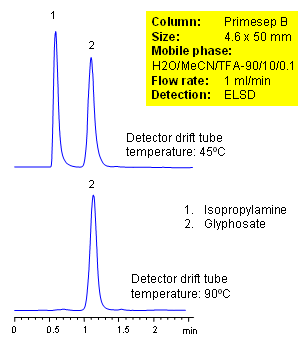
| Column | Primesep B, 4.6×50 mm, 5 µm, 100A |
| Mobile Phase | MeCN/H2O |
| Buffer | TFA |
| Flow Rate | 1.0 ml/min |
| Detection | ELSD |
| Class of Compounds |
Insecticide, Herbicide, Fungicide, Hydrophobic, Ionizable |
| Analyzing Compounds | Glyphosate, Isppropylamine |
Application Column
Primesep B
The Primesep family of mixed-mode columns offers a wide variety of stationary phases, boasting unprecedented selectivity in the separation of a broad array of chemical compounds across multiple applications. Corresponding Primesep guard columns, available with all stationary phases, do not require holders. SIELC provides a method development service available to all customers. Inquire about our specially-tailored custom LC-phases for specific separations.
Select optionsIsopropylamine

Separation of Glyphosate by Cation Exchange and Anion Exchange
July 6, 2003
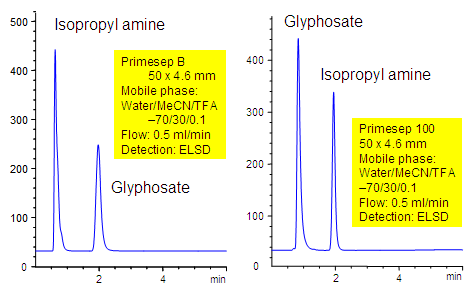
Primesep 100 separates a mixture of glyphosate and isopropylamine by HPLC using cation exchange as a retention mechanism. The peak order of this mixture is reversed on a Primesep B column which uses anion exchange. This combination offers an alternative to ion chromatography for the simultaneous analysis of complex herbicide mixtures. Glyphosate, other phosphonomethyl herbicides, and their amine salts can be analyzed with a mobile phase mixture of water, acetonitrile (MeCN, ACN) and trifluoroacetic acid (TFA) and evaporative light scattering detection (ELSD).
| Column | Primesep B, Primesep 100, 4.6×50 mm, 5 µm, 100A |
| Mobile Phase | MeCN/H2O |
| Buffer | TFA |
| Flow Rate | 0.5 ml/min |
| Detection | ELSD |
| Class of Compounds |
Insecticide, Herbicide, Fungicide, Hydrophobic, Ionizable |
| Analyzing Compounds | Glyphosate, Isppropylamine |
Application Column
Primesep 100
The Primesep family of mixed-mode columns offers a wide variety of stationary phases, boasting unprecedented selectivity in the separation of a broad array of chemical compounds across multiple applications. Corresponding Primesep guard columns, available with all stationary phases, do not require holders. SIELC provides a method development service available to all customers. Inquire about our specially-tailored custom LC-phases for specific separations.
Select optionsPrimesep B
The Primesep family of mixed-mode columns offers a wide variety of stationary phases, boasting unprecedented selectivity in the separation of a broad array of chemical compounds across multiple applications. Corresponding Primesep guard columns, available with all stationary phases, do not require holders. SIELC provides a method development service available to all customers. Inquire about our specially-tailored custom LC-phases for specific separations.
Select optionsIsopropylamine

